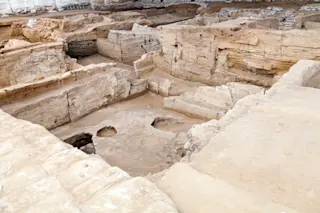There are two reasons, according to Jim Adovasio, we don’t think of baskets or textiles when we think of the Stone Age. One is that stones and bones, being far more durable, are far more common at archeological sites than artifacts made of fiber. But the other reason, says Adovasio, an archeologist at Mercyhurst College in Erie, Pennsylvania, is a bias on the part of archeologists who study the era. The Upper Paleolithic record has largely been interpreted by males who are closet macho hunters of the steppes--if not explicit ones, he says. Their emphasis has been on stone technology, large-animal hunting, and the accoutrements of machismo. Weaving isn’t as exciting as running around sticking things into mammoths.
And yet it has been around a long time, as four small pieces of clay described by Adovasio this past year make clear. Found at a site called Pavlov in the Czech ...














